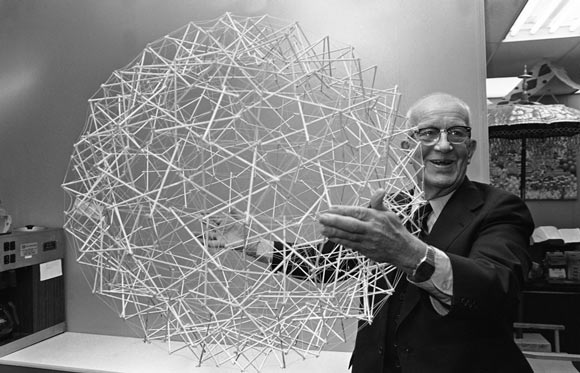Buckminster Fuller invented “Geodesic Dome”
Richard Buckminster Fuller was a well known American engineer, inventor, architect and author of the 20th century. He was born on 12 July 1895 in Milton, Massachusetts. His great aunt Margaret Fuller was a renowned author and literary critic who remained an inspiration throughout his life. Fuller had had poor eyesight since childhood and was very fond of nature. He graduated from Milton Academy in 1913 and then enrolled at Harvard University. However, he was expelled in 1914 for spending all his tuition money frivolously. He was reinstated only to be expelled again for lack of interest in his studies.
His mother decided to ship him off to Canada to work at a relative’s factory where he impressed the chief engineer with his mechanical ability and vision in design. He was encouraged to sketch his designs in a notebook which he did meticulously. He returned to New York and secured a job in the meat packing business. In 1917, he married Anne Hewlett and the couple had two children. During World War I he joined the Navy and while employed in their service, he invented a “winch” which would help pull sunken aircrafts out of the water with speed and accuracy and save the lives of hundreds of pilots.
He returned to New York in 1919 due to family troubles; his only child Alexandra had contracted meningitis. She died three years later, which left Fuller in a state of prolonged depression and anxiety. He started a business with his father in law, called Stockade Building Systems to provide affordable and efficient housing to lower income groups. However, the business was bought out by another company and Fuller lost his position. This further enhanced his depressed state and according to some records, he contemplated suicide, even after the birth of their second daughter Allegra. At this point he reports having a vision and hearing a voice directing him to apply himself towards helping others. This became a turning point in his life; he spent the remainder of his life studying, designing, inventing and promulgating energy efficient tools and strategies.
Fuller designed and patented the Dymaxion house, car and bathrooms. The Dymaxion house was a mass produced home that could be easily airlifted to different locations. The Dymaxion car was a streamlined versions of the original that was much more efficient in turning and handling. The Dymaxion bathroom was a compact, ready to install bathroom unit that could fit into any house like a puzzle piece. His most important invention, the “geodesic dome” came in 1947. This was the culmination of his lifelong struggle for efficient design – it was spherical in shape, and more space efficient, structurally strong and futuristic in design than regular structures supported by pillars.
Fuller’s design earned him worldwide acclaim, especially with architectural students. He licensed nearly 200 companies to build geodesic domes on his behalf and charged a 5% royalty. During his lifetime alone, more than 3000 domes had been erected. One of these was one with a 100 foot diameter, erected at the 1956 International Trade Fair held in Kabul, Afghanistan. It was delivered by plane and erected within 48 hours using a safe and innovative construction method that Fuller himself had devised. The most famous one was a 250-foot diameter, 23-storey high dome exhibited at the Montreal Expo in 1967.
Buckminster Fuller was a prolific author, poet and lecturer; he visited more than 500 different universities, where he met with students, listened to their ideas and lectured them on an impromptu basis. He was appointed as the Charles Eliot Norton Professor of Poetry at Harvard from 1961 to 1962. He wrote around 20 books and explored the theme of sustainable development by utilizing resources efficiently and minimizing waste. He received more than a 100 awards including the Presidential Medal of Freedom in 1983, held at least 25 teaching and academic positions and was awarded 47 honorary degrees. He died in Los Angeles, California in 1983, followed by his wife Anne within 36 hours of his own death.
